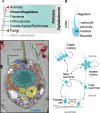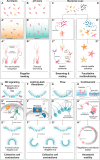What is it like to be a choanoflagellate? Sensation, processing and behavior in the closest unicellular relatives of animals
- PMID: 37067637
- PMCID: PMC10770216
- DOI: 10.1007/s10071-023-01776-z
What is it like to be a choanoflagellate? Sensation, processing and behavior in the closest unicellular relatives of animals
Abstract
All animals evolved from a single lineage of unicellular precursors more than 600 million years ago. Thus, the biological and genetic foundations for animal sensation, cognition and behavior must necessarily have arisen by modifications of pre-existing features in their unicellular ancestors. Given that the single-celled ancestors of the animal kingdom are extinct, the only way to reconstruct how these features evolved is by comparing the biology and genomic content of extant animals to their closest living relatives. Here, we reconstruct the Umwelt (the subjective, perceptive world) inhabited by choanoflagellates, a group of unicellular (or facultatively multicellular) aquatic microeukaryotes that are the closest living relatives of animals. Although behavioral research on choanoflagellates remains patchy, existing evidence shows that they are capable of chemosensation, photosensation and mechanosensation. These processes often involve specialized sensorimotor cellular appendages (cilia, microvilli, and/or filopodia) that resemble those that underlie perception in most animal sensory cells. Furthermore, comparative genomics predicts an extensive "sensory molecular toolkit" in choanoflagellates, which both provides a potential basis for known behaviors and suggests the existence of a largely undescribed behavioral complexity that presents exciting avenues for future research. Finally, we discuss how facultative multicellularity in choanoflagellates might help us understand how evolution displaced the locus of decision-making from a single cell to a collective, and how a new space of behavioral complexity might have become accessible in the process.
Keywords: Basal cognition; Choanoflagellates; Multicellularity; Origin of animals; Sensation.
© 2023. The Author(s).
Conflict of interest statement
The authors declare no competing or financial interests.
Figures



Similar articles
-
Choanoflagellate models - Monosiga brevicollis and Salpingoeca rosetta.Curr Opin Genet Dev. 2016 Aug;39:42-47. doi: 10.1016/j.gde.2016.05.016. Epub 2016 Jun 17. Curr Opin Genet Dev. 2016. PMID: 27318693 Review.
-
Genomic innovation of ATD alleviates mistranslation associated with multicellularity in Animalia.Elife. 2020 May 28;9:e58118. doi: 10.7554/eLife.58118. Elife. 2020. PMID: 32463355 Free PMC article.
-
The Capsaspora genome reveals a complex unicellular prehistory of animals.Nat Commun. 2013;4:2325. doi: 10.1038/ncomms3325. Nat Commun. 2013. PMID: 23942320 Free PMC article.
-
Selective factors in the evolution of multicellularity in choanoflagellates.J Exp Zool B Mol Dev Evol. 2021 Apr;336(3):315-326. doi: 10.1002/jez.b.22941. Epub 2020 Mar 21. J Exp Zool B Mol Dev Evol. 2021. PMID: 32198827 Review.
-
Cell differentiation controls iron assimilation in the choanoflagellate Salpingoeca rosetta.mSphere. 2025 Mar 25;10(3):e0091724. doi: 10.1128/msphere.00917-24. Epub 2025 Feb 26. mSphere. 2025. PMID: 40008892 Free PMC article.
Cited by
-
The evolution of multicellularity and cell differentiation symposium: bridging evolutionary cell biology and computational modelling using emerging model systems.Biol Open. 2024 Jul 15;13(10):bio061720. doi: 10.1242/bio.061720. Epub 2024 Oct 7. Biol Open. 2024. PMID: 39373528 Free PMC article. Review.
-
Functional fibrillar interfaces: Biological hair as inspiration across scales.Beilstein J Nanotechnol. 2024 Jun 6;15:664-677. doi: 10.3762/bjnano.15.55. eCollection 2024. Beilstein J Nanotechnol. 2024. PMID: 38887525 Free PMC article. Review.
-
Dynamics of neural activity in early nervous system evolution.Curr Opin Behav Sci. 2024 Oct;59:101437. doi: 10.1016/j.cobeha.2024.101437. Epub 2024 Aug 6. Curr Opin Behav Sci. 2024. PMID: 39758090
-
Electrical signaling and coordinated behavior in the closest relative of animals.Sci Adv. 2025 Jan 10;11(2):eadr7434. doi: 10.1126/sciadv.adr7434. Epub 2025 Jan 8. Sci Adv. 2025. PMID: 39772683 Free PMC article.
-
Chemical cognition: chemoconnectomics and convergent evolution of integrative systems in animals.Anim Cogn. 2023 Nov;26(6):1851-1864. doi: 10.1007/s10071-023-01833-7. Epub 2023 Nov 28. Anim Cogn. 2023. PMID: 38015282 Free PMC article.
References
-
- Alberts B. Molecular biology of the cell. 5. New York: Garland Science; 2008.
Publication types
MeSH terms
Grants and funding
LinkOut - more resources
Full Text Sources

